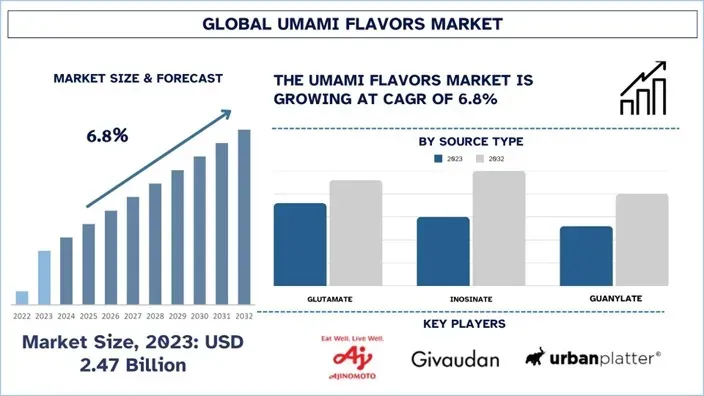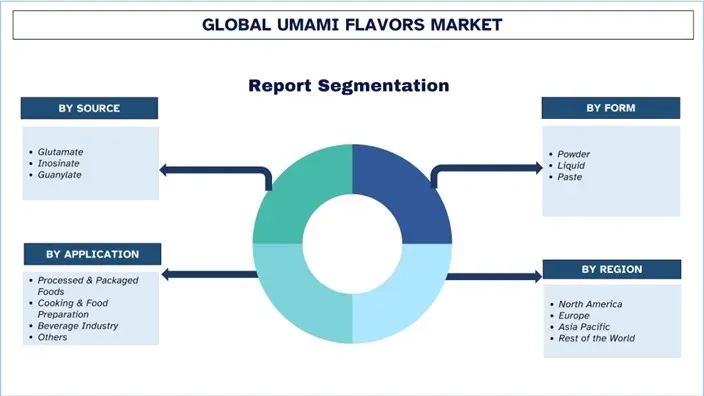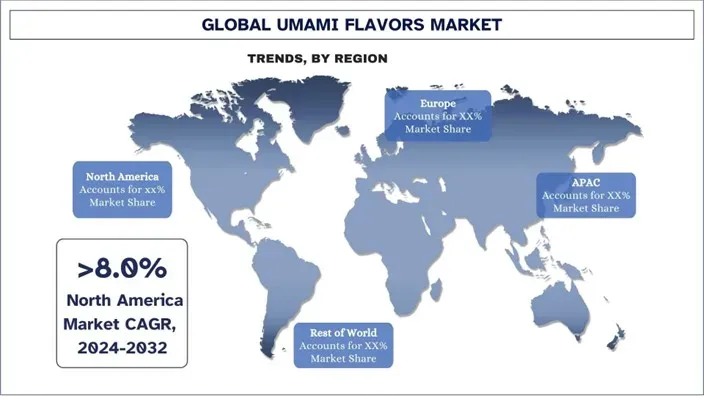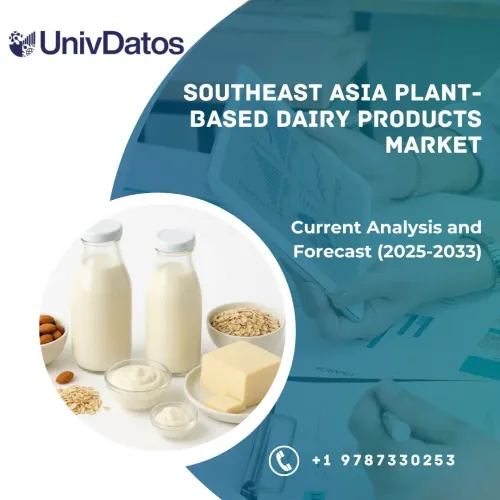- Home
- About Us
- Industry
- Services
- Reading
- Contact Us
Umami Flavors Market: Current Analysis and Forecast (2024-2032)
Emphasis on Source (Glutamate, Inosinate, and Guanylate), Form (Powder, Liquid, and Paste), Application (Processed & Packaged Foods, Cooking & Food Preparation, Beverage Industry, and Others); and Region/Country

Umami Flavors Market Size & Forecast
The Umami Flavors Market was valued at approximately USD 2.47 billion in 2023 and is expected to grow at a substantial CAGR of around 6.8% during the forecast period (2024-2032) owing to increasing consumer demand for rich, savory taste profiles in processed foods, snacks, and plant-based alternatives, along with the expansion of the processed food industry.
Umami Flavors Market Analysis
Umami flavors are savory, meaty taste sensations that add depth and complexity to food. Experts refer to umami taste as one of five primary sensory perceptions, along with sweet, sour, bitter, and salty. Umami flavors are derived from glutamate, inosinate, and guanylate, which are pairs of amino acids and nucleotides discovered in foods consisting of tomatoes, mushrooms, aged cheeses, soy sauce, seaweed, and fermented items. The Japanese scientist "Kikunae Ikeda" discovered umami in 1908, and this discovery launched a historical journey of food flavor enhancement because it significantly boosts palatability in culinary dishes. Food manufacturers employ monosodium glutamate (MSG) and yeast extracts as well as hydrolyzed vegetable proteins to increase the taste of processed foods and snacks, seasonings, as well as alternative protein-based products for industry. The food industry embraces Umami because it enables sodium reduction in foods without sacrificing taste and matches all the requirements of health-conscious clean-label formulations. Hence, accelerating the growth of the umami flavors market worldwide.
The umami flavor market expands because consumers seek convenient foods that contain umami ingredients to deliver better taste and reduced sodium levels. The development of plant-based and alternative protein items reflects the increasing usage of umami-rich ingredients that deliver deep deliciousness to meat replacement products. Natural and clean-label umami-flavored products enjoy increased market demand from health-conscious consumers who are dependent on sources such as yeast extracts, mushrooms, and seaweed-based flavor enhancers for their products. The market demonstrates strong growth potential because of rising food service demand, quick-service restaurant expansion, and rising global culinary tastes. Additionally, technological advancements in the food manufacturing process, along with efficient fermentation methods, enable food scientists to develop unique solutions that boost umami taste intensity.
Umami Flavors Market Trends
This section discusses the key market trends influencing the various segments of the umami flavors market as identified by our research experts.
Expansion of Umami in Ready-to-Drink (RTD) Beverages
Ready-to-drink (RTD) beverages are undergoing an expansion with umami flavors because consumers seek strong, sophisticated tastes and additional health advantages. The savory base component of umami finds its way into new beverage formulations, which include health-centric and premium ready-to-drink beverages. The functional beverage market incorporates umami-rich ingredients from mushrooms, seaweed extracts, miso, and fermented vegetables, which improve both flavor depth and nutritional quality of products such as protein shakes and plant-based drinks. Mixologists and beverage brands explore umami as a flavored ingredient in their cocktail creations and cold brews, and botanical-infused drinks to attract adventurous consumers who want distinctive taste experiences. Beverage makers are inspired by social media trends toward umami to establish this flavor category as promising for future market expansion. The growing interest in exploration on social media platforms and culinary pursuits has contributed to the rising demand for umami-flavored drinks, which indicates their potential to become a leading beverage category in the future.
Umami Flavors Industry Segmentation
This section provides an analysis of the key trends in each segment of the global Umami Flavors market report, along with forecasts at the global, regional, and country levels for 2024-2032
The Glutamate Segment Dominates the Umami Flavors Market
Based on the source, the glutamate segment maintains the dominant position in the umami flavors market because it functions as the main umami-active compound that is extensively consumed by the food industry. Processed foods, seasonings, snacks, and instant meals contain the most prominent glutamate-based flavor enhancers, which include monosodium glutamate (MSG), yeast extract, and hydrolyzed vegetable proteins. This segment leads the market because of its low-price structure as well as its high operational performance along with its wide application in different food products. However, the Inosinate segment is expected to show high expansion in the forecasted period. Food producers use inosinate from fish, meat, and mushrooms to enhance the umami flavor. The inosinate-based umami enhancers derived from plant and fermentation-based sources are driving future market expansion because of the increased focus of consumers on natural and clean-label alternatives.
The Processed and Packaged Market Dominates the Umami Flavors Market
Processed and packaged foods applications maintain the maximum market share in the umami flavors sector because umami-rich ingredients are frequently used in instant noodles, frozen meals, along with snacks, canned soups, and seasonings. Food manufacturers use these flavors as consumers nowadays are interested in convenience foods and ready-to-eat meals with extended shelf life. However, the cooking and food preparation segment is expected to experience significant growth as consumers pursue diverse cooking interests, including homemade gourmet and international cuisines. The growth of this segment results from consumers moving toward unprocessed seasonings with natural origins while demanding umami-rich condiments and sauces in their meal kits. The market expansion trajectory depends on these trends, which motivate consumers to choose umami-rich alternatives as they contain less sodium.

North America is expected to be the fastest-growing region.
The demand for health-oriented products with clean ingredients stands as the main market force that drives the expansion of umami flavors across the North America region. Increased consumer health awareness drives them toward finding natural options that can replace artificial additives and preservatives, as well as high-sodium ingredients. The flavor-arousing properties of umami allow food manufacturers to boost the complexity of their food items by choosing natural alternatives instead of artificial seasonings or large salt quantities. The increasing knowledge about harmful sodium health effects, such as hypertension and cardiovascular diseases, has motivated food producers to mix umami-rich elements like mushrooms, seaweed, miso, tomatoes, and yeast extracts to develop tasty yet sodium-reduced food products. The consumer desire for plant-based functional foods has increased because people seek natural flavors with nutritional values that match their eating choices.
The U.S. Dominates the North American Umami Flavors Market
In the United States umami flavors market growing fast rises due to expanding consumer taste for flavorful salty food items. The interest in plant-based diets and global food brings more people to use natural umami boosters like yeast extracts and fermented ingredients instead of MSG replacements. The market grows due to customer acceptance of products that combine sodium reduction with better taste. Food businesses now use umami flavors to enhance processed foods, snacks, and plant-based meat options because consumers want new taste experiences. Changing eating habits and new food development will push the U.S. umami flavor industry ahead in future market developments.

Umami Flavors Industry Overview
The umami-flavored market is competitive, with several global and international players. The key players are adopting different growth strategies to enhance their market presence, such as partnerships, agreements, collaborations, new food product launches, geographical expansions, and mergers and acquisitions. Some of the major players operating in the market are Ajinomoto Co., Inc., Givaudan, Urban Platter, Kerry Group plc, Sensient Technologies, International Flavors & Fragrances Inc., Jeneil Biotech, Keva Flavours Pvt. Ltd., Symega, and The MANE Group.
Recent Developments in the Umami Flavors Market
In March 2024, Umami United Japan Co., Ltd. launched a plant-based matcha gelato, which was crafted without the use of dairy or eggs. It featured unadjusted organic soy milk, koji sweet sake, soy butter, umami egg flavor, and abundant Japanese matcha, delivering a refined bitterness and rich matcha aroma.
In January 2024 - Holland & Barrett launched soy & honey umami paste, which was a combination of three umami-rich ingredients, soy sauce, honey, and dried mushrooms, to create a flavor boost that makes all other ingredients in a dish more intense.
In December 2022 - Anna Paganelli launched a miso and shiitake super-boost powder, which was a potent combination of fermented miso and other umami-rich ingredients, all of which were organically sourced and slow-dried for maximum impact. This umami-based seasoning deepens the flavor of savory dishes, adds body, and lifts bland foods, such as plain rice and pasta, into another league.
Umami Flavors Market Report Coverage
Report Attribute | Details |
Base year | 2023 |
Forecast period | 2024-2032 |
Growth momentum | Accelerate at a CAGR of 6.8% |
Market size 2023 | USD 2.47 Billion |
Regional analysis | North America, Europe, Asia-Pacific, Rest of the World |
Major contributing region | North America is expected to grow at the highest CAGR during the forecasted period. |
Key countries covered | U.S., Canada, Germany, France, UK, Spain, Italy, China, Japan, and India |
Ajinomoto Co., Inc., Givaudan, Urban Platter, Kerry Group plc..., Sensient Technologies, International Flavors & Fragrances Inc., Jeneil Biotech, Keva Flavours Pvt. Ltd., Symega, and The MANE Group. | |
Report Scope | Market Trends, Drivers, and Restraints; Revenue Estimation and Forecast; Segmentation Analysis; Demand and Supply Side Analysis; Competitive Landscape; Company Profiling |
Segments Covered | By Source, Form, By Application, By Region/Country |
Reasons to Buy the Umami Flavors Market Report:
The study includes market sizing and forecasting analysis validated by authenticated key industry experts.
The report presents a quick review of overall industry performance at a glance.
The report covers an in-depth analysis of prominent industry peers with a primary focus on key business financials, product portfolios, expansion strategies, and recent developments.
Detailed examination of drivers, restraints, key trends, and opportunities prevailing in the industry.
The study comprehensively covers the market across different segments.
Deep dive regional-level analysis of the industry.
Customization Options:
The global umami flavors market can be customized further as per the requirement or any other market segment. Besides this, UnivDatos understands that you may have your own business needs; hence, feel free to contact us to get a report that completely suits your requirements.
Table of Content
Research Methodology for the Umami Flavors Market Analysis (2022-2032)
We analyzed the historical market, estimated the current market, and forecasted the future market of the global Umami Flavors market to assess its application in major regions worldwide. We conducted exhaustive secondary research to gather historical market data and estimate the current market size. To validate these insights, we carefully reviewed numerous findings and assumptions. Additionally, we conducted in-depth primary interviews with industry experts across the Umami Flavors value chain. After validating market figures through these interviews, we used both top-down and bottom-up approaches to forecast the overall market size. We then employed market breakdown and data triangulation methods to estimate and analyze the market size of industry segments and sub-segments.
Market Engineering
We employed the data triangulation technique to finalize the overall market estimation and derive precise statistical numbers for each segment and sub-segment of the global Umami Flavors market. We split the data into several segments and sub-segments by analyzing various parameters and trends, including source, form, application, and regions within the global Umami Flavors market.
The main objective of the Global Umami Flavors Market Study
The study identifies current and future trends in the global Umami Flavors market, providing strategic insights for investors. It highlights regional market attractiveness, enabling industry participants to tap into untapped markets and gain a first-mover advantage. Other quantitative goals of the studies include:
- Market Size Analysis: Assess the current and forecast market size of the global Umami Flavors market and its segments in terms of value (USD).
- Umami Flavors Market Segmentation: Segments in the study include areas of source, form, application, and regions.
- Regulatory Framework & Value Chain Analysis: Examine the regulatory framework, value chain, customer behavior, and competitive landscape of the Umami Flavors industry.
- Regional Analysis: Conduct detailed regional analysis for key areas such as Asia Pacific, Europe, North America, and the Rest of the World.
- Company Profiles & Growth Strategies: Company profiles of the Umami Flavors market and the growth strategies adopted by the market players to sustain in the fast-growing market.
Frequently Asked Questions FAQs
Q1: What is the umami flavors market's current size and growth potential?
The umami flavors market was valued at USD 2.47 billion in 2023 and is projected to grow at a CAGR of 6.8% from 2024 to 2032. This growth is driven by increasing demand for savory taste enhancers, clean-label ingredients, and plant-based umami solutions.
Q2. What are the key factors driving the growth of the umami flavors market?
• Rising consumer demand for savory and rich-tasting foods.
• Increasing use of natural flavor enhancers like MSG, yeast extracts, and fermented ingredients.
• Growth of the processed food industry, particularly in convenience and ready-to-eat meals.
• Expansion of plant-based and clean-label umami products to cater to health-conscious consumers.
Q3. Which umami flavor source holds the largest market share?
The glutamate segment holds the largest share in the umami flavors market, as monosodium glutamate (MSG) and other glutamate-rich compounds are widely used in food manufacturing to enhance taste, texture, and depth of flavor.
Q4. What are the major trends shaping the umami flavors market?
• Hybrid and fusion flavors: Increasing demand for cross-cultural culinary experiences.
• Ready-to-drink umami-based beverages: Growth in umami-infused broths, teas, and protein drinks.
• Clean-label and natural flavor enhancers: Rising consumer preference for MSG-free and organic umami solutions.
• Technological advancements: AI-driven flavor formulation and fermentation-based umami extraction.
Q5. What are the biggest challenges in the umami flavors market?
• Regulatory restrictions on MSG and other synthetic umami enhancers in certain regions.
• Clean-label and consumer perception: Demand for transparency in ingredient sourcing and labeling.
• Supply chain limitations: Dependence on fermentation and biotech innovations for natural umami production.
• Price fluctuations of natural umami-rich ingredients like seaweed, mushrooms, and fermented extracts.
Q6. Which region leads the umami flavors market?
Asia-Pacific dominated the umami flavors market in 2023, driven by high consumption of savory food products, traditional fermented seasonings, and MSG-based flavor enhancers. North America and Europe are also witnessing rapid growth due to the rising demand for plant-based and clean-label umami ingredients.
Q7. Who are the key players in the umami flavors market?
Leading companies in the umami flavors industry include:
• Ajinomoto Co., Inc.
• Givaudan
• Urban Platter
• Kerry Group plc.
• Sensient Technologies
• International Flavors & Fragrances Inc.
• Jeneil Biotech
• Keva Flavours Pvt. Ltd.
• Symega
• The MANE Group
Q8. What are the latest innovations and technological advancements in the umami flavors industry?
• Plant-based umami enhancers derived from mushrooms, seaweed, and fermented legumes.
• Advanced fermentation techniques to extract umami compounds naturally.
• Biotechnology-driven umami solutions, such as precision fermentation for flavor optimization.
• AI-powered flavor formulation to create complex umami profiles with clean-label ingredients.
Q9. How do regulatory policies impact the umami flavors industry across different regions?
• U.S. (FDA) and European Union (EFSA) regulations impose labeling and safety standards on MSG and other umami enhancers.
• Asia-Pacific countries have more lenient regulations, supporting the expansion of MSG-based products.
• Stricter clean-label requirements in North America and Europe are driving investments in natural and organic umami alternatives.
• Sustainability standards and transparency in ingredient sourcing are influencing product formulations.
Related Reports
Customers who bought this item also bought










